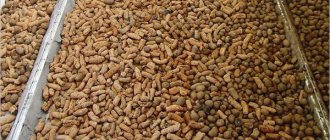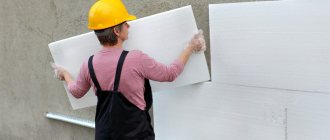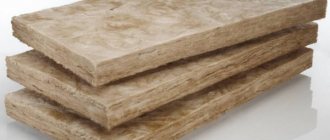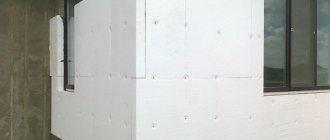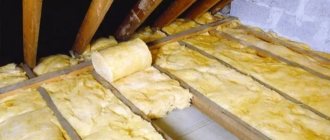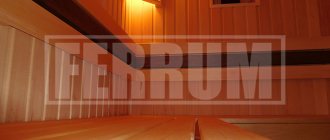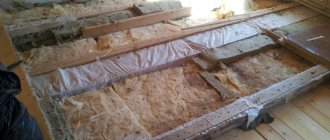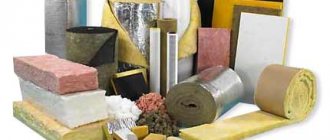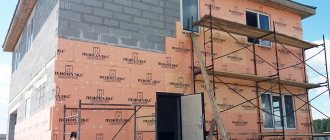Vadim
6023 0 0
Vadim August 25, 2016
There are now quite a few different types of insulation materials competing on the modern market. But for more than half a century, expanded clay has been considered one of the most popular materials. In this article I will tell you how to insulate floors, ceilings and walls with expanded clay in different conditions with your own hands and in what cases it is worth doing.
This is what expanded clay looks like.
Expanded clay advantages and disadvantages
Like any material, expanded clay has its pros and cons.
To make an informed choice, you need to get acquainted with the properties of insulation. Among the products of this type offered on the market, expanded clay is not a new product: it has been used for several decades and has managed to prove itself to be of the best quality. Bulk thermal insulation consists of granules of 3 different fractions. Any type of expanded clay is suitable for roof insulation; materials of different sizes can also be combined
It is important to know that effective insulation of the ceiling from the cold can only be achieved by backfilling a layer 30-40 cm thick
Expanded clay granules are made from fired slate clay. During the firing process, the surface of the lump is sintered, and the inner layer acquires pronounced porosity, noticeable at the fracture. It is the cavities of the bubbles that give expanded clay its insulating properties, since air has relatively low thermal conductivity. Materials such as penoizol, EPS, polystyrene foam, etc. are constructed using the same principle. But, compared to them, expanded clay has its advantages.
Among the advantages of granular thermal insulation made of clay:
absolute fire safety, since expanded clay does not burn, does not melt and does not release harmful substances when heated; lightness, which is important when insulating the ceiling; resistance to mold, rot or damage by rodents, since ceramics are biologically stable and quite hard; ease of use of the material; long service life - expanded clay can withstand more than 25 cycles of thawing and freezing and does not decompose.
The price of 1 m³ is low and comparable to the cost of other heat insulators (mineral wool, expanded polystyrene).
Among the disadvantages, the most obvious drawback is the presence of dust generated during the firing and transportation of granules. Like other insulating materials, expanded clay is capable of absorbing moisture, which reduces its insulating properties. All insulation materials have an increased tendency to absorb moisture. It can be considered a disadvantage, but the easiest way is to take appropriate measures and protect the insulating material from water.
Bulk material is inconvenient for insulating suspended ceilings. Despite their lightness, the granules have weight and create additional stress on the coating.
Useful tips
When the ceiling opens onto a residential attic, you need to pour expanded clay so that there is a gap between it and the attic floor covering. If this is not done, the grains will constantly creak under the feet of those who walk above. But when backfilling is done correctly, expanded clay will also serve as a soundproofing material.
Sometimes it is necessary to insulate sloping attic ceilings. For this purpose, it is better to choose other types of insulation. Bulk material cannot be laid on an inclined surface: round granules will roll down. Expanded clay backfill is used only on a horizontal plane.
Self-leveling mixtures should not be used to fill expanded clay screed. The liquid mass will flow between the granules until it saturates the entire insulation, and when the thickness of the layer is large, the repair will cost a lot of money. If you need to make poured floors in the attic, you first need to lay a concrete screed, and then apply a thin layer of leveling mixture.
By pouring expanded clay to a thickness of only 10 cm, you can already save up to 70% of the heat that escapes into the atmosphere through the ceilings. The popularity of expanded clay for insulating ceilings in private wooden houses is due to its low thermal conductivity and low price
The fire safety of granules is also important.
Ceiling insulation with expanded clay has been carried out since the production of this material at the beginning of the last century. The popularity of using expanded clay has not faded to this day. Floor insulation with expanded clay performs three protection functions: thermal insulation, sound insulation and moisture insulation.
Lightweight expanded clay used for floor insulation consists of porous, ceramic granules formed by the expansion of special clays at high temperatures.
Directions for using light expanded clay:
- Insulation base.
- Filler for concrete blocks and panels.
- Hydroponics.
- Drainage of areas.
The insulation installation is carried out in three ways: dry filling, combined filling, wet screed using factory-made dry building mixtures.
The technology for insulating the ceiling using the dry backfill method is performed using expanded clay of different fractions. If you backfill only with granules of one fraction, the density of the layer will be non-uniform, which will negatively affect its thermal conductivity. If you mix up granules of the middle fraction of 5-10 mm and granules up to 5 mm, then the filling will be dense and non-shrinking: small granules will fill the spaces between the middle ones, resulting in a homogeneous layer.
Checking the quality of the coating
After the insulation of the ceiling with expanded clay in a bathhouse or house has been completed, you need to wait a few days and find out whether all the work was done correctly. To do this, the heating on the floor below is turned on at full power for a couple of hours, after which the temperature in the attic is measured. If it is strikingly different from the one without heating, then you need to carefully examine the thermal insulation layer. If necessary, the lining is opened and installed where the heat passes. This cannot be ignored, otherwise there is no point in installing insulation.
Thus, doing all the work yourself is not as difficult as it might seem. Before insulating the ceiling with expanded clay, it is enough to calculate how many materials are needed and purchase everything you need. If you follow simple instructions, the repair will take a few days and will not cause any difficulties.
What is expanded clay
Expanded clay is a small-sized granule, due to its small pores it has little weight. These granules are obtained by firing clay. We can safely assure you that expanded clay is also an environmentally friendly natural material, moreover, it is characterized by relatively good technical indicators, such as:
- Noise and sound insulation - muffles impacts;
- Thermal insulating properties – retains heat well;
- Frost resistance - does not collapse even at low temperatures;
- Fire resistance - the material is not exposed to fire;
- Strength - its structure does not change under the influence of water (hot and cold);
- Durability - the properties of expanded clay do not change even when exposed to high or low temperatures; it lasts much longer than other insulation materials.
Technology of ceiling insulation with expanded clay granules
Before insulating the ceiling, be sure to lay a layer of membrane (polyethylene, for example) that is impervious to dust and vapors.
In cases where thermal insulation is installed in a bathhouse, this becomes especially important due to the large amount of water vapor in the air. No other preparatory actions are required: the loose insulation will perfectly fill all the unevenness and easily penetrate into niches and gaps between structural elements. To work on ceiling insulation you will need the following materials and tools:
- thick polyethylene film or isolon, foil, etc.;
- scotch;
- expanded clay of any fraction;
- bucket and shovel;
- a tool for leveling the backfill (even a rake will do);
- cement and sand for screed, sheet materials for covering - if necessary.
Screed or flooring is done if it is planned to use the attic space as a residential or utility room. Their installation is optional and remains at the discretion of the owner.
How to insulate a concrete floor?
For concrete floors, expanded clay, as a ceiling insulation, is an ideal material.
Concrete, impermeable to dust and vapors, does not require even minimal preparation. Therefore, backfilling can be done in just a few hours. To make the expanded clay layer even, you need to install beacons made of thin bars or boards at a height equal to the thickness of the layer. These elements are leveled horizontally using a building level.
When purchasing expanded clay, you need to take into account the shrinkage coefficient of the granules. It is approximately equal to 1.2, so it is better to buy a little more. Laying consists of pouring the contents of the bags between the beacons and leveling the layer using the rule. If desired, you can do without beacons, taking level measurements directly along the backfill.
If you do not plan to walk in the attic, then it is enough to lay a layer of polyethylene on top, connecting the panels with tape. The film protects the backfill from moisture from the atmosphere. But you can protect expanded clay in another way:
- Pour the granules with cement laitance (a liquid solution of cement in water) and dry the backfill for at least 7 days.
- Lay the reinforcing mesh on top and make a screed of cement-sand mortar.
A screed on top of expanded clay will protect the bulk material from moisture and make it possible to move around the heat insulator without the risk of destroying its layer. The ability to retain heat with this method does not suffer at all.
Ceiling insulation in a wooden house
The technology for insulating the ceiling in a wooden house involves the use of a moisture barrier.
To do this, you can take any material from those that are used for a similar purpose. The most affordable is plastic film. It is advisable to lay a waterproofing layer across the ceiling joists to securely cover them too. The width of the film is usually no more than 3 m, so individual strips will have to be joined together. This is also done using a certain technology:
- roll out a strip of polyethylene over the surface, covering the beams protruding above it;
- lay the next panel with an overlap of at least 5 cm on the previous one;
- Tape the joint with wide stationery tape.
When the polyethylene is laid, a protective material should be applied to it. For this you need ordinary clay. It needs to be crushed (a fraction of about 1 cm) and covered between the joists with a layer of 5 cm.
What layer of expanded clay is needed to insulate the ceiling in this case? According to building codes, expanded clay insulation begins to effectively perform its function at a thickness of 10 cm. This layer is sufficient for thermal insulation of a bathhouse or garage that does not require constant heating.
In a private house in central Russia, the entire space between the joists will have to be filled with insulation until a thickness of about 20 cm is achieved. Only in this case will it be possible to properly insulate the home. Calculating the volume of granules in cubic meters is simple: you need to calculate the area of the ceiling and multiply it by the thickness of the layer, expressing the value in meters. Add about 20% to the resulting figure for shrinkage.
It is best to buy expanded clay of different sizes: by mixing a large fraction with a smaller one, you can achieve a dense layer that practically does not lose height. Backfilling is done in the same way as in the previous case. When using a rake to level the granules, you should turn them over with their teeth facing up so as not to tear the polyethylene. After the heat insulator is laid, polyethylene is again spread over it and the log, joining the strips with an overlap and securing them with tape.
Tiled floor in the sink of a wooden bathhouse
The technology, in fact, differs only at the very end - it is necessary to form a slope towards the ladder. And so, everything is the same. The bottom of the pit is compacted, crushed stone is laid out in layers, and compacted. Next, you can make a slab with a strength of M150 and a thickness of 3.5-4 cm, or pour crushed stone with lean concrete. The second option is more economical.
How to make a tiled floor in a washroom
We lay expanded polystyrene in two layers. The slabs of the second layer overlap the seams of the first. This is for better thermal insulation. The first layer slabs can be attached to the base with long nails with plastic heads. The sheets are glued together with tape, you can foam the seams with foam, cut off the excess and lay out the second layer.
The floor in the shower also needs to be insulated
Next, spread a layer of PVC film on the polystyrene foam. This, again, is to prevent the solution from flowing. We roll out a damper tape around the perimeter of the room, lay out reinforcement or reinforcing mesh, set up beacons (don’t forget to form a slight slope towards the ladder) and fill in the screed. Once the concrete has hardened sufficiently, the tiles can be laid.
Is it possible to lay tiles if the floor is made with joists? Quite. Again, there are options. You can lay plywood on the subfloor (don’t forget about the slope). Or maybe not plywood, but slate sheets. It is even preferable, since their thermal expansion with tiles is closer than with plywood. Then you can lay the tiles using a special tile adhesive. Special - this is for complex unstable foundations. It is expensive, but the cost of preparatory layers is less.
Still, in wet areas there is nothing better than tiles
You can also pour screed onto the plywood and lay tiles on it. But this makes sense if you are using water heating for the floor from heating or from a warm water tank. If it is electric, then it can be laid directly on plywood.
How is expanded clay produced?
Expanded clay is produced in several stages:
Low-melting clay, which is the starting material, is loaded into a thermal chamber, in which it is softened to the state of dough.
Then the material is quickly heated under the influence of a temperature of 1000-1300 degrees Celsius - this leads to the fact that the raw material “boils”. “Boiling” promotes the formation of voids in the material, upon cooling of which porous granules are formed - expanded clay fractions.
Under the influence of high temperatures, the surface of the material will melt - thus, a good sealed shell appears, which has high qualities of strength and wear resistance, and resistance even to mechanical stress and damage.
The quality of the future product directly depends on how accurately all the rules of technology were followed. Since information on the production of expanded clay also contains information about its environmental friendliness, the question of whether expanded clay is harmful automatically disappears.
Ceiling insulation with expanded clay: pros and cons
The positive aspects stand out:
- Environmentally friendly, for use in residential premises;
- Availability of material, can be purchased in any region with delivery;
- Cheapness of the product;
- Low thermal conductivity coefficient, effective insulation;
- Non-flammable material;
- Absorbs noise;
- Shrinkage of the floor when exposed to high loads leads to cracking of the granules, compaction and increased thermal conductivity;
- The thickness of the backfill layer significantly reduces the height of the room;
- High labor costs when performing wet expanded clay concrete screed.
Nevertheless, this material is still used today. The production of expanded clay concrete slabs and blocks is in demand in low-rise construction. Lightweight floor slabs reduce the load on load-bearing walls, which can now be made from lightweight aerated concrete. Insulation of floors using expanded clay is a multidisciplinary stage of work.
Laying features
Beginners are often lost in the question of what layer of expanded clay gravel is required to reliably insulate walls and ceilings, and what additional elements are needed to create a heat-insulating “cushion.”
It is recommended to pour a thick layer of large expanded clay for complete insulation, but taking into account the total load on the ceiling. In cold regions, the height of the buried gravel reaches half a meter, and, despite the insignificant mass of the granules, the insulation makes the structure heavier.
Gravel sand is poured under the main layer, and in addition, two types of insulation are laid under the bulk material and on top of it: steam and hydro. To reduce the cost of the project, polyethylene or roofing felt is used, but the vapor barrier is broken, since the film creates a greenhouse effect, and condensation accumulates if the room is poorly ventilated.
When planning to pour only one fraction, spread the membrane fabric, choose which optimal layer is needed, and scatter the expanded clay to the height required for insulation, evenly distributing it over the surface of the ceiling.
To enhance the insulation and sound insulation of a wooden or concrete ceiling, the material is compacted by mixing sand with expanded clay.
The same effect is achieved by combining gravel with smaller granules. You can increase the heat saving rate by filling the granular insulation with concrete. In this case, there is no need to place a vapor barrier under the screed.
Professionals do not recommend insulating the top floor if it is the ceiling of a flat roof without an attic. This applies to both bathhouses and residential buildings. Expanded clay is highly hygroscopic, which negatively affects the thermal insulation properties of granules.
Whatever fraction of clay expanded clay you take, during work and use as insulation the material emits dust, and therefore for a plank ceiling an additional layer to contain dust is required.
The optimal thickness is 10 cm, a thinner layer of expanded clay is ineffective for insulation, and in regions with low temperatures, the height of the embankment starts from 20-40 cm, subject to the appropriate ceiling height or the possibility of its reconstruction.
The different size fraction and lightness of expanded clay allows you to create an effective heat-saving “cushion”. All insulation work is simple and it is possible to install the ceiling yourself, without special construction experience. Consumers are also attracted by the low cost of the material, the lack of special equipment for installation, and the effectiveness.
Nuances you need to know during construction
To ensure that your expanded clay concrete house lasts a long time, is warm and reliable, it is important to familiarize yourself with the intricacies of construction technology using expanded clay concrete blocks. The first point is to choose the type of material to work with.
For example, if you are planning to build a low-rise building, then the best option for work would be structural and thermal insulating expanded clay concrete blocks, whose density is in the range of 700–1200 kg/m3. Less light and dense materials are suitable for insulation, but multi-storey buildings are built from heavy (structural) blocks
The first point is to choose the type of material to work with. For example, if you are planning to build a low-rise building, then the best option for work would be structural and thermal insulating expanded clay concrete blocks, whose density is in the range of 700–1200 kg/m3. Less light and dense materials are suitable for insulation, but multi-storey buildings are erected from heavy (structural) blocks.
Important! The lower the density of the material, the better its thermal insulation properties, and vice versa. The second point is that it is important to choose the right size of products
If you want to make your house warm while reducing energy costs, then the walls of the house should be at least 40 cm thick. One of the popular block sizes in the construction of load-bearing walls is 190x188x390. Walls made of blocks, the thickness of which is from 90 to 120 mm, serve as self-supporting partitions of the house.
The second point is that it is important to choose the correct size of the products. If you want to make your house warm, reducing energy costs, then the walls of the house should be at least 40 cm thick
One of the popular block sizes in the construction of load-bearing walls is 190x188x390. Walls made of blocks, the thickness of which range from 90 to 120 mm, serve as self-supporting partitions of the house.
The third point is that the foundation for a house made of expanded clay blocks must be made strong and deep. The depth of the foundation is selected taking into account the type of soil, freezing point and location of groundwater, however, it is not less than 1 m. Be sure to make a sand cushion with a layer of 20 cm, and also pour an armored concrete belt of 20 cm. In this case, the frame consists of 5 or 6 reinforcement rods Ø18 mm. If the soil settles, the walls and foundation of a house made of expanded clay concrete will not crack.
The fourth point is that it is better to do the insulation and finishing of the building at the same time - this is beneficial in order to save money. That is why you need to select the facing material and insulation in advance. You can cover the walls of the house with siding, blockhouse, facing brick or facade plaster. Mineral wool or polystyrene foam is suitable as insulation.
Advice! To prevent the formation of cold bridges through the seams, jute tape is used when laying the house. It is laid in the middle of the masonry, preventing cold from passing through the solution.
Fifth point - the laying of expanded clay concrete blocks must be reinforced. This is done once every 3 or 4 rows using reinforcement rods, Ø12 or 14 mm. Grooves or grooves are made in the blocks, where the rods are laid. After which everything is sealed with cement mortar.
Advice! An armored belt must be made before installing the floor slabs, if the expanded clay concrete house is two-story, and also before installing the roof.
Rules for working with expanded clay
Firstly, expanded clay should be poured only onto the substrate. It is better to use a vapor barrier substrate. The side covered with a layer of foil should be laid towards the room to be insulated. This especially needs to be done when expanded clay is used as ceiling insulation in a bathhouse.
Thirdly, the thickness of expanded clay for insulation should be from ten to twenty centimeters.
There are several types of expanded clay. They all differ in purpose. Three types of expanded clay are usually sold:
- Expanded clay crushed stone. It measures from 0.2 to 0.4 cm and has an angular shape. Only the foundations of buildings and structures are insulated with this expanded clay.
- Expanded clay gravel is used to insulate the ceilings of buildings. This expanded clay has a small fraction of approximately 0.1 to 0.2 cm and a round shape.
- The finest of expanded clay is the so-called expanded clay sand. This sand is not used for insulation.
Classification of heat insulator by fractions
The variety of material is determined by the size of the fraction, i.e. size of granulates:
- Small. According to the parameters, it is 0.1-5.0 mm. Used as a bulk mixture for backfill. Also used in the production of concrete blocks.
- Average. Reaches sizes of 10-20 mm, called gravel. Construction experts consider this fraction of expanded clay to be better for insulating ceilings, floors and floors of buildings.
- Big. Sizes vary in the range of 20-40 mm. Expanded clay of this fraction is used to insulate roofs, basements and semi-basements, as well as floors in garages and cellars.
Today, the building materials market offers about ten varieties of expanded clay. The distribution of types of material is carried out due to the density of the filling level. Thus, expanded clay of a large fraction has a lower density. Thus, the lower the grade and density of the granulate, the higher the quality.
Advantages and disadvantages of ceiling insulation with expanded clay
Expanded clay has more than enough advantages, so let’s focus on the most important of them:
- The insulator is highly durable among many other materials.
Expanded clay is fireproof because it does not burn and does not emit substances hazardous to human health into the atmosphere.
Thanks to its special porous structure, this insulator weighs much less than other similar materials.
It is not edible and is not attractive to various bugs, rodents, bacteria, mold and fungi.
The low price of the material explains the fact why it has been successfully used for ceiling insulation for decades.
High thermal insulation qualities are complemented by excellent sound insulation properties, since it quickly absorbs acoustic vibrations.
The material easily absorbs moisture without increasing its own weight or losing its basic qualities.
Expanded clay chips or crushed stone do not cause allergic reactions in households or animals due to their natural origin.
Like other bulk-type thermal insulation, expanded clay is very easy to use.
Thanks to the fractional release form, the air between the individual pebbles further improves thermal insulation and produces natural convection.
Let's consider the possible negative aspects that may be associated with the use of expanded clay as a heat insulator:
- Its effectiveness is directly related to the thickness of the insulating layer. In other words, there is no point in making the thickness of the bedding less than 20, or even 40 centimeters.
This material must be reliably protected from atmospheric moisture or precipitation.
It is optimal to use it for thermal insulation over reinforced concrete floors. Firstly, they are quite monolithic in themselves and are able to withstand the weight of expanded clay. Secondly, they reliably keep crumbs and dust from spilling down.
When insulating houses made of wood, expanded clay must be protected by a vapor barrier on both the top and bottom sides.
It is not recommended to pour this insulator onto a ceiling that is attached to the beams below. Considering the weight and volume of expanded clay, it is possible that it will be able to break through the entire structure, which will collapse inside the room.
Negative aspects of insulation
Insulating walls with expanded clay also has disadvantages. They are:
- The material is not recommended for use in very damp rooms. It will take a long time to dry, temporarily losing its characteristics. But, this drawback is solved by using a waterproof membrane.
- Dry granules generate dust when handled. Therefore, the thermal insulation process must be performed in a respirator.
- Since expanded clay is a granular material, it should be compacted when laying it so that it does not shrink later.
- For a private house, garage, basement, the thickness of the expanded clay layer should be within 50 cm or more.
As you can see, the insulation has much fewer disadvantages. Some of them immediately disappear when it comes to wall insulation.
